
What Is Content Repurposing? Definition, Tactics, and Examples
[ad_1]
Repurposing content is the solution to most of your content problems.
Do you find it difficult for you to come up with new content ideas every day? Reuse existing posts that performed well.
Are you short on time to keep up with content creation for multiple platforms? Recycle one of the older posts on a different platform.
This article will help you leverage this content marketing strategy to take your content game to the next level.
Contents
What is content repurposing?
Repurposing content means re-using all or parts of an existing content piece and presenting it differently to reach a wider audience. It makes your content accessible to a diverse audience with different learning styles.
For example, you can turn your blog post into a social media post to target people who like to consume quick content and are present on social media.
Plus, this content strategy keeps your content schedule busy with lesser effort.
Why should you repurpose content?
The most obvious benefit of repurposing content is saving time in the content creation process. You don’t need to create every video, blog post, or infographic from scratch.
You have an existing piece of content, which you can either take inspiration from (saving time in research) or use as is for another platform.
Apart from this, other key reasons to repurpose your content are:
1. Target a wider audience
To target different audiences, you need to create content for different platforms. For example, your Twitter followers might not be the same as your newsletter subscribers.
This is no easy task, especially when dealing with limited time and resources. That’s where content repurposing comes in.
You can use the same content piece and post it on a different platform, without sounding repetitive because a completely different set of audience is consuming the new content.
Here’s how Recipe30, a popular food channel, reuses the website blog posts into videos.
Recipe30 created an in-depth blog post on a soup recipe. This type of blog commonly targets people who learn best via reading. Recipe30 then transforms the blog post into a YouTube video, targeting visual and auditory learners.
Considering it’s a recipe, there are a lot of people who want to follow a video while cooking. While the blog content has more instructions than a video, both content pieces are created according to the platform.
And the YouTube video:
This helps them increase their audience, while also having a high publishing velocity. Instead of hiring a scriptwriter to create a new script, using an existing blog helps save time and money.
2. Get an SEO boost
When you share multiple pieces of content centered around a few main keywords, it signals the search engine crawlers that your site is an authority in that niche.
On top of that, you get an opportunity to link back to your main content source via different platforms. This boosts your rankings and generates more traffic.
Taking the same example of Recipe30: They interlink both the content pieces – YouTube videos and blogs to get more traffic from one to another. Here’s how they’ve linked the blog under the description of the YouTube video:
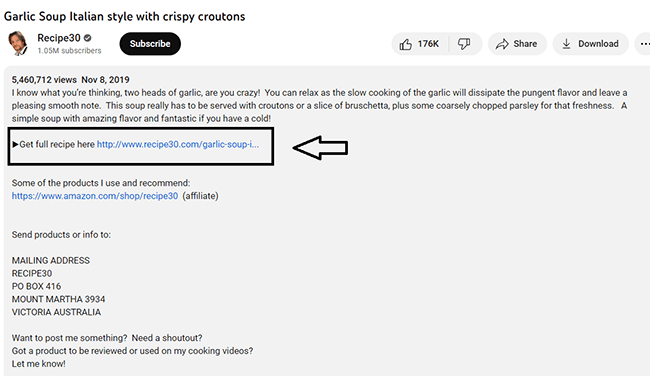
On the other hand, here’s how they linked the YouTube video to the blog:
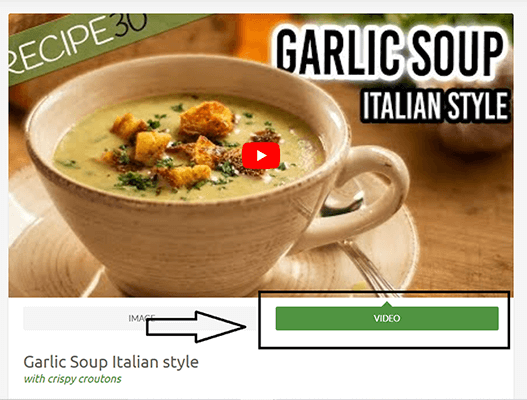
3. Get the most out of your popular content
Content repurposing gives you a second chance at the content promotion of a well-established piece of content.
You might’ve published an article a few years back that got you a lot of engagement and leads. This is a qualifier for a content idea – it has worked in the past and is likely to work again.
The blog on the garlic soup recipe by Recipe30 is one of the top-ranking search results for that keyword. This acts as proof that the topic is relevant and people are searching for it. Because of this proof, they can be certain that the new video might get just as popular.
…And it did.
The YouTube video became one of the top-ranking videos, both on YouTube and other search engines.
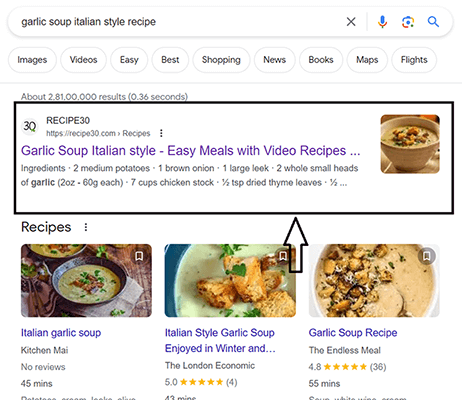
And on YouTube:
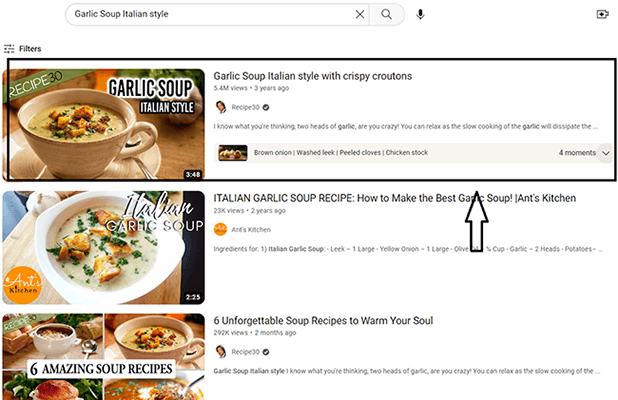
4. Maintain your publishing frequency
With an average person spending around 7 hours consuming content daily, you need to stay on top of your audience’s minds and maintain a publishing frequency. Instead of spending time and money creating new content, you can add repurposing old content to your content schedule.
For example, with a lot of content published on their blog, Recipe30 is now able to post regularly, doing recipe roundups on their YouTube channel with over 800 videos:
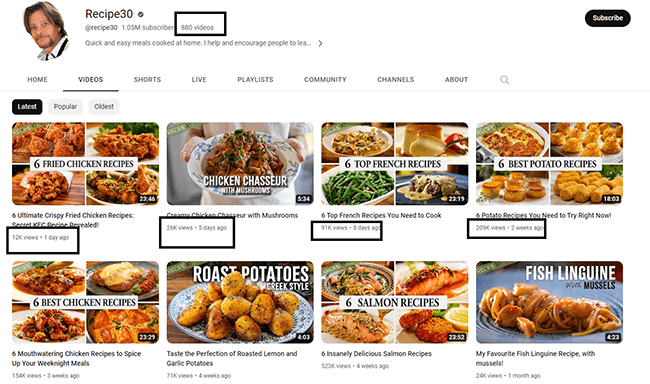
Which content should you repurpose?
Instead of repurposing every content you have produced, you can get better results by following these four steps:
1. Audit existing content and shortlist high-performing content
Conduct a content audit to sort the best-performing content on your website. You can use a tool like Semrush’s Content Audit tool or Google Analytics to get started. But before you start, set your goals for repurposing and define your high-performing content for repurposing.
Ask questions like: What does high-performing content mean for your business?
Is it the content that brings the most traffic? Or the one that brings the most conversions? Are you looking for high engagement, or do you want to filter the topics to include those that talk specifically about your business or product?
Depending on this, you can shortlist your metrics from reach, shares, number of mentions, organic visibility, higher rankings, linking structure, etc.
Once done, you can select the content based on these metrics.
2. Look for evergreen content
Topical content is great – but that requires you to keep editing the content to make it relevant with time. If you want content that’s one-and-done, while also bringing in consistent traffic, without frequent edits, evergreen content is the way to go.
For example, there’s always an influx of topical content during an event like the Super Bowl. But would people still search for such a topic after the event is over?
Content A: What to cook on a Super Bowl evening
Content B: What to cook when friends are coming over
While both are great topics right now, the first talks of an event that has already occurred and, thus, repurposing that would be of little use.
To find these evergreen posts, you can either do a manual check or use tools like Google Analytics to find the pages that are getting the most traffic consistently.
3. Review feedback on your posts
There’s a goldmine that businesses often miss out on. And it’s the comments on your posts or articles.
Audience feedback gives you insights into what your audience really wants.
This can help you refurbish and repurpose your content in the right way. Based on the feedback, you can analyze if you want to modify something and then repurpose it. For example, if someone points out that the topic “X” seems irrelevant or missing out on key details, you can add the details in the repurposed content.
Plus, if a content piece was particularly popular with your target audience, it qualifies the content piece for a good engagement rate.
8 examples of content repurposing
Here are eight ways to get started with content repurposing:
1. Turn blog posts into infographics
Infographics are the fourth-most popular content formats used by businesses and marketers today.
The reason is simple: People process visual content faster than all-text content.
Search engines also show images as part of the results for search queries. Your infographic can turn up in this query to get more traffic to your content. Here’s an example for the keyword “emotional intelligence”:
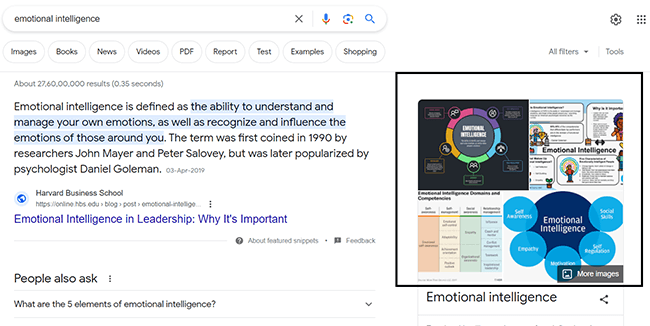
While choosing a blog post to create an infographic, select data-heavy ones or ones with a process that you can break down into steps for your infographic.
Here’s how ThinkPsych targets the same “emotional intelligence” keyword by repurposing an infographic from a blog post.
You can also post these infographics to Instagram and Pinterest to grow your reach there.
Here are some best practices to follow while creating infographics:
- Use the right visual type from timelines, bar charts, photos, scatter plots, Venn diagrams, and maps.
- Keep your target audience and platform in mind. For example, the infographics you create for Twitter (short to fit the platform’s image dimensions) would differ from the ones you create for your newsletter (a little longer and more descriptive).
- Draw attention to your headline. Keep it crisp and use relevant keywords.
- Adhere to best design practices like using white space, having a clear hierarchy, using matching illustrations, and sticking to consistent fonts and themes.
- Use tools like Visually and Visme to create appealing infographics. Here are some more free tools you can use.
2. Turn webinars into video tutorials
If you had a successful webinar with a lot of sign-ups and attendees, think of those who couldn’t make it.
If this webinar was a huge hit a year back, chances are your new audience would love it, too.
Instead of letting that webinar go to waste, convert it into a video tutorial. Many brands do this by converting the webinar into a YouTube video that people can consume anytime.
This helps in two ways: let your video remain live forever (theoretically) and drive new visitors to your website through YouTube.
Here’s how Clip Studio Paint turned their webinar into a YouTube tutorial – garnering over 37,000 views:
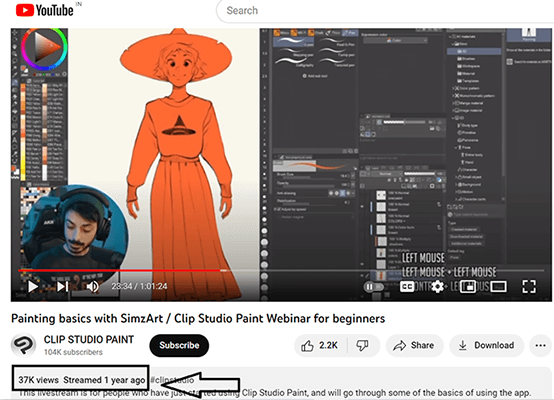
Pro tip: Don’t make the mistake of turning every webinar into a video tutorial immediately. That way, you discourage your viewers from actually attending your webinar.
Instead, space out the video releases to maintain exclusivity.
As of 2022, over 4 billion people use social media globally. This number has kept on increasing over the years and is estimated to continue doing so.
If you aren’t actively creating content for these users, you’re missing out on a lot of engagement potential.
Here are three different ways you can repurpose content for social media platforms:
1) Turn articles into carousels on Instagram
Turning your how-to or listicle posts into carousels is a great way to reach a wider audience.
Take Klara Kernig, an Instagram creator for example. She turns her high-quality content on Substack into Instagram carousels to make the content easy to read:
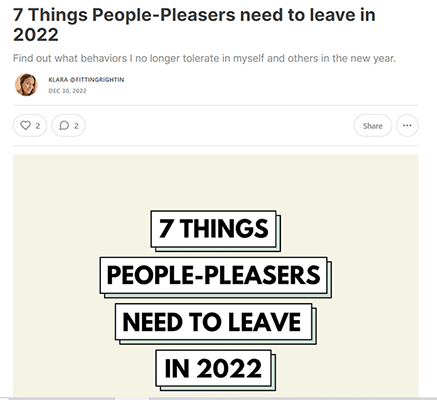
This is how the blog looks as an Instagram carousel:
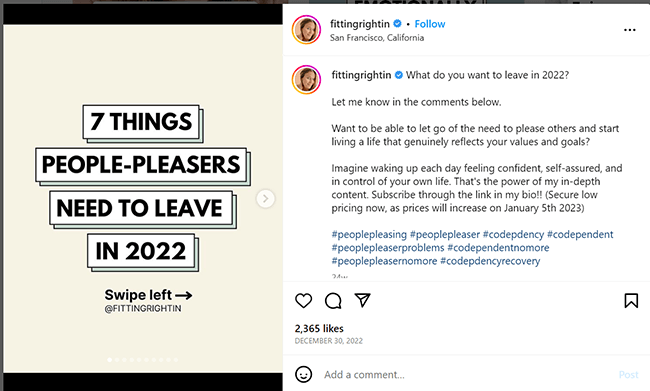
Just sharing your article link on Twitter isn’t enough. So many businesses have taken it one step further by converting the important bits of the article into a Twitter thread.
Here’s how Ahrefs turned a blog into a Twitter thread:
3) Turn articles into YouTube shorts
While TikTok has been the leader of the shorter video format, YouTube Shorts has recently surpassed TikTok with an MAU (Monthly Active Users) of 1.5 billion.
Taking the same example of Recipe30, they repurpose their blogs and long-form videos into shorts on YouTube:
They even link back to the blogs under the Shorts, creating a sort of content ecosystem:
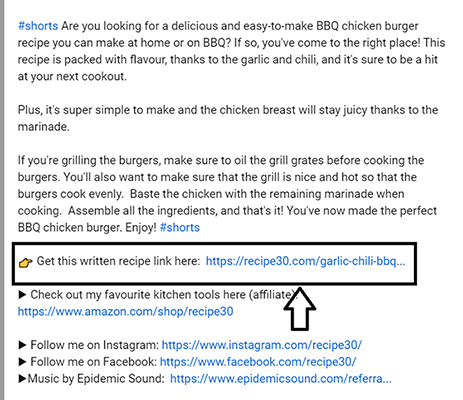
If you’re short on time, you can use social media automation tools like Missinglettr to turn your articles into social media posts quickly.
4. Turn an article series into an Ebook
Gated content in the form of ebooks can generate a lot of leads when published properly. For example, FaChords complements its blog posts with relevant ebooks:
Ebooks can be a great way to get leads data and engage people.
Instead of creating an ebook from one article, combine relevant articles or use an article series.
Here’s an example.
Article A: How to start learning guitar chords
Article B: How many guitar chords are there
Article C: 7 songs to play using simple chords
Ebook compilation: The ultimate guide to guitar chords
Here are some best practices for creating engaging ebooks:
- Have an interesting and descriptive headline to draw readers in.
- Create an ebook structure with easy navigation. This doesn’t overwhelm the reader; they can easily skip or jump to the sections they want.
- Use visual elements to make the ebook more attractive and easy to read.
- Talk about your product or service wherever relevant.
- Make it mobile-friendly.
- Have a CTA at the end.
5. Turn visual content into a Pinterest board
If you have a lot of visual content to share, you can turn this into a Pinterest board.
With almost 60% of women making up Pinterest’s global audience, it can be a good fit for your brand if you’re targeting women.
For example, brands like fashion or beauty can get a lot of clicks to their website by strategically using the platform.
Here’s how brands like Maybelline New York are making the most of their Pinterest boards.
Pro tip: You can easily repurpose the content you create for Instagram or TikTok for your Pinterest boards.
An email newsletter allows you to provide ongoing value to your audience and keep them engaged with your brand.
If you don’t want to invest too much into creating content for your newsletter, you can share the important parts of your recent blog posts in the newsletter.
Many companies also do a roundup of their recent blog posts so subscribers don’t miss out on anything.
For example, Beardbrand, a men’s grooming brand, creates informative newsletters, which link back to their videos or blogs:
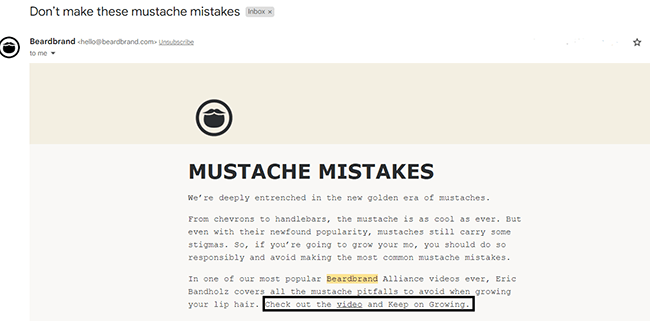
This newsletter is linked back to a YouTube video with over one million views, which in turn links to their blog. It might sound complicated but that’s a solid content ecosystem!
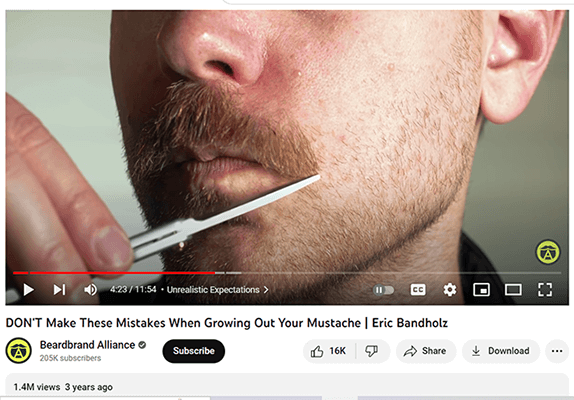
These kinds of newsletters are relatively easy to create and can be a great solution for small businesses.
7. Turn listicles into a slide deck
Because of the visual format and platforms like Slideshare, slide decks help you draw many readers and increase your overall traffic.
For example, Buffer received almost equal views on their slide decks as some of their most popular posts.
The best part?
They created these slide decks from their articles in around 2-3 hours. To date, they’ve got over 12 million views from these slide decks. Their referral traffic also increased, and they started generating more leads.
Here’s an example of a listicle they turned into a slide deck.
You can use tools like Canva and SlideModel to create these slide decks.
To create better slide decks,
- Choose the right article. For example, a listicle or a statistically-heavy article would make a great slide deck.
- Stay consistent with your color scheme, imagery, typography, and styling.
- Incorporate the right visuals. For example, graphs for statistics and animations to explain a complicated process.
- Don’t lengthen the slide deck unnecessarily. Stick to the most important bits of your article.
- Don’t use many fancy effects or transitions. Keep it simple.
8. Turn a video series into a podcast
Podcasts have become a go-to content format for many in the last few years – with an audience of 464 million podcast listeners monthly. It helps you connect to your audience on a different medium and build authority in your niche. By inviting credible people in your niche and consistently providing value-driven content, you prove your authority in the niche.
While you might need some equipment to create a video tutorial, podcasts are a less expensive content format and can be effortlessly created with tools like Alitu and Telbee.
One way to supercharge the creation process is by turning your popular videos into podcasts.
Here’s how the web design company, 37signals, creates a podcast on taking sabbaticals after a YouTube video that touched on the same topic.
Here are some strategies you can follow:
- Invite guests to your show. Bonus points if they’re popular in your niche.
- Provide a theme to each episode so listeners know what will be covered.
- Include episode transcriptions to make your show accessible to people with impaired hearing or someone who wants a quick read.
- Create a podcast trailer to generate enthusiasm about your upcoming episodes.
4 tactics to help you repurpose content
Now that you know the different ways to repurpose your content, here are four tactics that can help you create effective content.
1. Follow the best practices of each platform
Different platforms have their own sets of dos and don’ts.
For example, while you may want to experiment with visual content on Instagram, you can work with a mix of visual and text content on Twitter.
Look how Todoist converts an article into a thread with tips and an image that draws the reader’s attention.
While repurposing your blog content into a carousel for Instagram, make it aesthetically pleasing to make your content stand out. You might even wish to follow a consistent theme so the audience can recognize your brand whenever they see your post.
While this may take some time to master, the return in the form of increased engagement and possible conversions will be worth it.
2. Refurbish and republish your older posts
Your content needs to be tweaked and refurbished as trends keep on changing all the time.
For example, an article on “AI writing tools” should now include the likes of Jasper, Writesonic, and other relevant tools.
By refreshing content, many businesses have seen an improvement in their rankings and backlink profile. For example, if there’s a popular article from two years back bringing traffic in, you might want to keep refreshing it to keep it relevant.
This also helps you with repurposing. After that content refresh, you can create a new and updated repurposed post from it.
For example, by updating an old article on brand ambassadors, Zapier managed to get a quick traffic boost.
They have also managed to get the top-ranking spot for the keyword “best time tracking apps” for 5 years in a row due to constant updates.
Google also mentioned way back that their algorithm gives a score to your pages based on how relevant and fresh the content is. It also helps provide a relevant experience to your users based on recent changes and developments.
3. Learn from the best in your niche
Instead of aiming in the dark with your repurposing strategies, notice how your competitors are doing it.
Since you’re targeting the same audience, you can gain an idea of the most popular content formats by seeing what works for them.
You can analyze the following while doing competitor research:
- On what platforms are they most active?
- Do they repurpose content often? If yes, how?
- After how much time do they repurpose a post?
- On which platforms are they getting the most engagement?
Based on the answers to these questions, you can create solid repurposed content.
4. Collaborate with an influencer
Influencer marketing is still growing exponentially, with 71% of marketers finding the traffic quality led by influencers better than other traffic sources.
This means you need to get creative with your influencer marketing strategies.
For example, while repurposing a blog post into a TikTok video, you can collaborate with an influencer in your niche.
Give new life to your existing content by repurposing
Many businesses think of repurposing as an afterthought. Instead, build it proactively into your content strategy by thinking of different ways to repurpose a piece of content before you start creating it.
This way, you already have ideas to keep your content game alive and thriving on different platforms.
While you create a repurposing strategy, note that experimentation is the key to success. The more you experiment and analyze, the better you’ll shape your strategy.
[ad_2]





